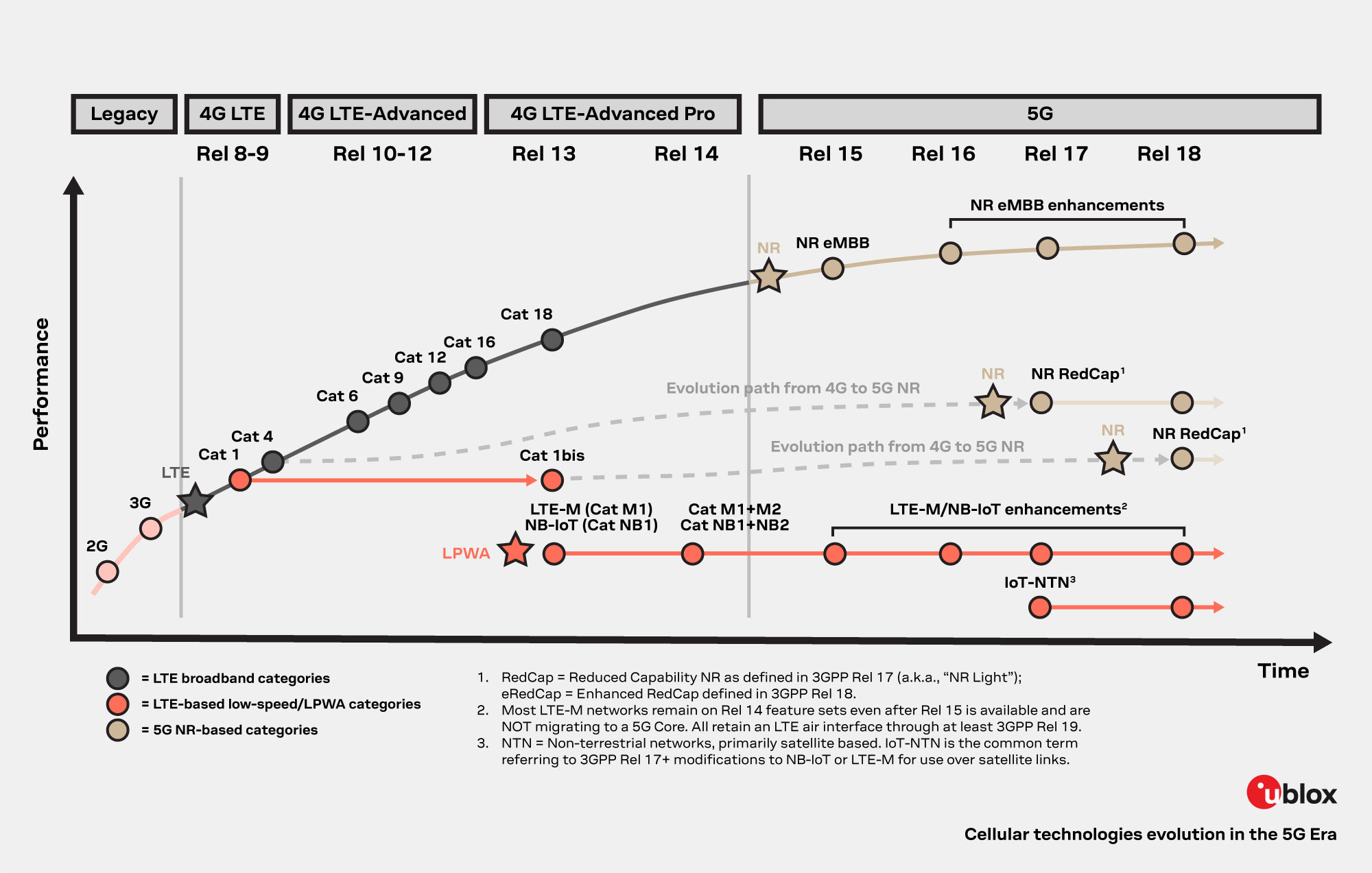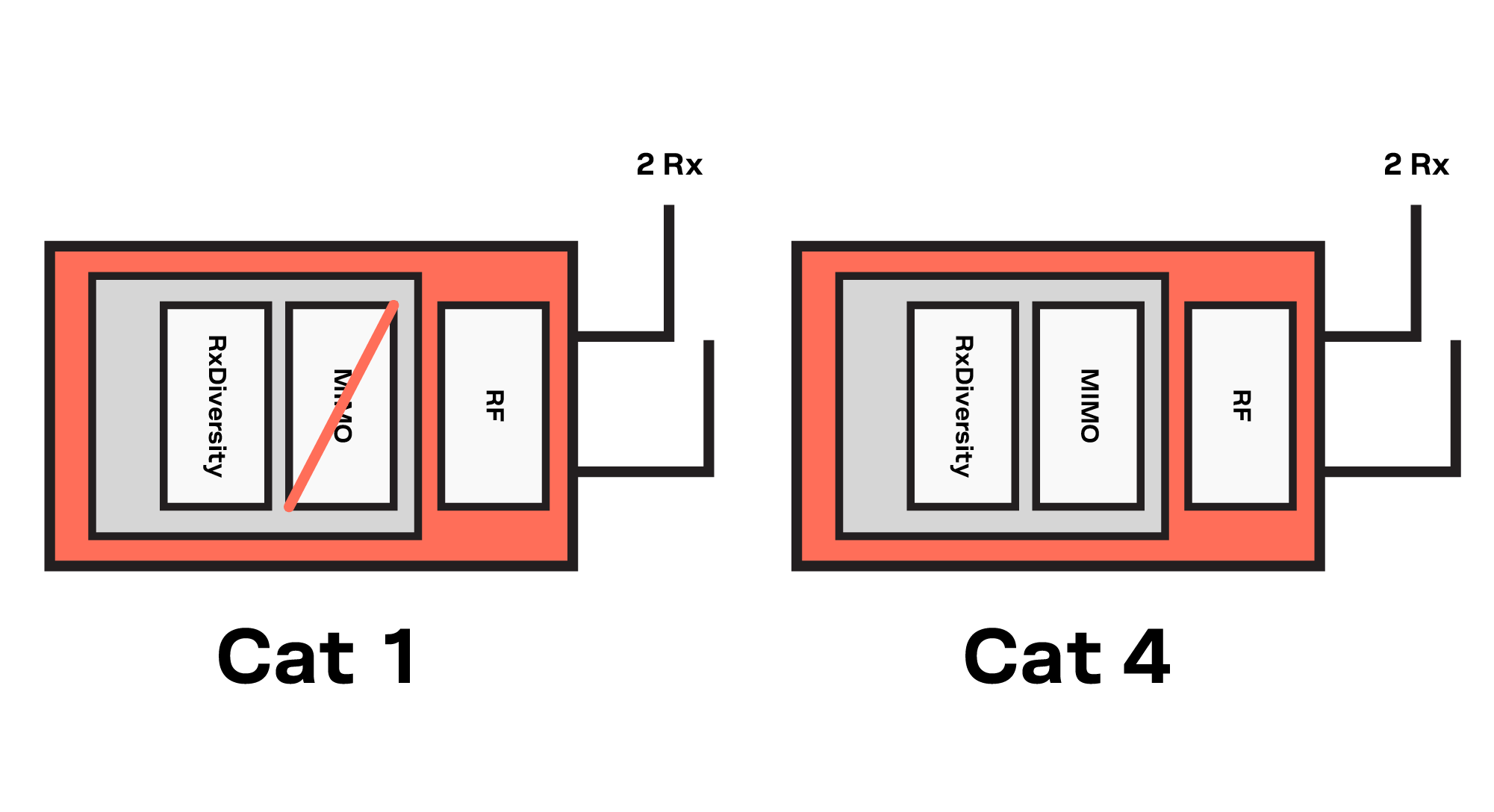
- Support portal
- Evaluation Kits and partner products
u-blox Support
- Product documentation
Documentation
- Investor relations
Investor relations
Technology
|
23 May 2024
LTE Cat 4 is the highest and most powerful LTE category prior to LTE Advanced (LTE-A).
LTE Cat 4 provides data rates ranging from tens to hundreds of Mbps with a reduced design effort and affordable total cost of ownership in a very compact design.
With just one additional TX antenna than LTE Cat 1, LTE Cat 4 boosts the data rate about a 10x factor providing also
making it the perfect solution for IoT applications requiring higher throughputs, global portability with an affordable solution implementation.
LTE Cat 4 is the most common and simpler high speed LTE category prior to those classified “LTE Advanced”.

Why simple? Compared to higher LTE categories classified under LTE-Advanced domain, the LTE Cat 4 provides high data rates with a relatively simple hardware implementation effort.
On the one hand, LTE-A solutions require sophisticated MIMO (Multiple Input Multiple Output) Antenna arrays to provide the highest data rates and complex MIMO systems require extensive design effort, deep RF expertise, allocate a larger area in the board for the multiple antenna arrays with all the related additional costs.
On the other hand, LTE Cat 4 does not require sophisticated 4x4 or 8x8 MIMO antenna arrays and is able to provide high data rates with just one additional TX antenna compared to an LTE Cat1 design.
LTE Cat 4, with data rates up to 50Mbps in uplink and 150Mbps in downlink, is suitable to enable applications like high quality video surveillance, routers, and point-of-sale terminals. To provide this performance, the LTE Cat 4 makes use of the simplest MIMO configuration: the 2x2 MIMO (2 TX antennas and 2 RX antennas).

This solution provides high data rates with relatively simple integration compared to other MIMO solutions.
The table below reports some LTE category’s data and shows undoubtedly that LTE Cat 4 represents the best balance between data rate and cost (module cost and implementation cost) for IoT applications requiring higher data rates and global portability.
It is quite evident the stunning delta in data rate capability (more than 10x) between LTE Cat 1 and LTE Cat4 with a design requiring the addition of just one more antenna; going from pure RX diversity supported by LTE Cat 1 to 2x2 MIMO required by LTE Cat4.
| LTE Category | Max DL (Mbit/s) | Max UL (Mbit/s) | MIMO |
|---|---|---|---|
| 1 | 10 | 5 | NO, Only RX Diversity |
| 4 | 150 | 50 | 2x2 |
| 6 | 300 | 50 | 2x2 or 4x4 |
| 9 | 450 | 50 | 2 or 4 |
| 12 | 600 | 100 | 2 or 4 |
In most (but not all) of the IoT use cases, the outcoming throughput is much more relevant than the incoming one, so we can say that, statistically, uplink capability is more important than downlink for IoT applications. Exactly the contrary of the consumer market use case where internet surfing requires more downlink than uplink capability.
In the table above, we can easily see that the difference between a LTE Cat 1 and a LTE Cat 4 board design is one TX antenna but this simple difference in board design makes LTE Cat 4 solution able to provide data rates by a 10x factor, going from 5Mbps (provide by Cat 1) up to 50Mbps in Uplink.
Now, looking at the higher LTE-A categories, we don’t see such 10x factor in uplink with designs requiring more antennas, i.e., going from Cat 4 to Cat 6, 8, 12 and more .
The uplink capability sometimes increases by a 1.5x or 2x or more for higher LTE categories but the module cost and the implementation cost increases as well.
In fact, the cost difference between LTE Cat 4 and higher Cat LTE-A solutions is not negligible, considering not only the module’s acquisition cost but also the more complex RF design of LTE-A like 4x4 MIMO or 8x8 MIMO solutions.
So, we can say that LTE Cat4 is the true best balance between performance, coverage, and cost (module and implementation) and represents the perfect solution for several vertical IoT markets.
The sunset of 2G and 3G networks is accelerating: 24 Mobile Network Operators (MNOs) in 15 countries have already shut down their 2G networks, and 33 MNOs in 47 countries have done the same with their 3G networks. Today, the number of operators with 2G or 3G shutdowns underway is close to one hundred.
By 2025, there will be a massive 2G/3G shutdown, with almost 50 switch-offs planned only for that year.
In this scenario, with 5G still under deployment, the 4G LTE will be the only cellular technology with worldwide coverage for the next 5-10 years.
Most legacy IoT applications, those with low data rates but requiring global portability (thus excluding LTE-M or NB-IoT applications due to their regional deployments), will migrate to LTE Cat 1bis (or Cat 1, depending on the required features and operating region).
Legacy IoT applications with high data rates that Cat 1/Cat 1bis cannot satisfy will migrate to LTE Cat 4, which is the most convenient solution for them. In fact, LTE Cat 4 offers high data rates, global portability, and relatively low integration complexity, enabling the design of compact and high-throughput solutions at an affordable cost.